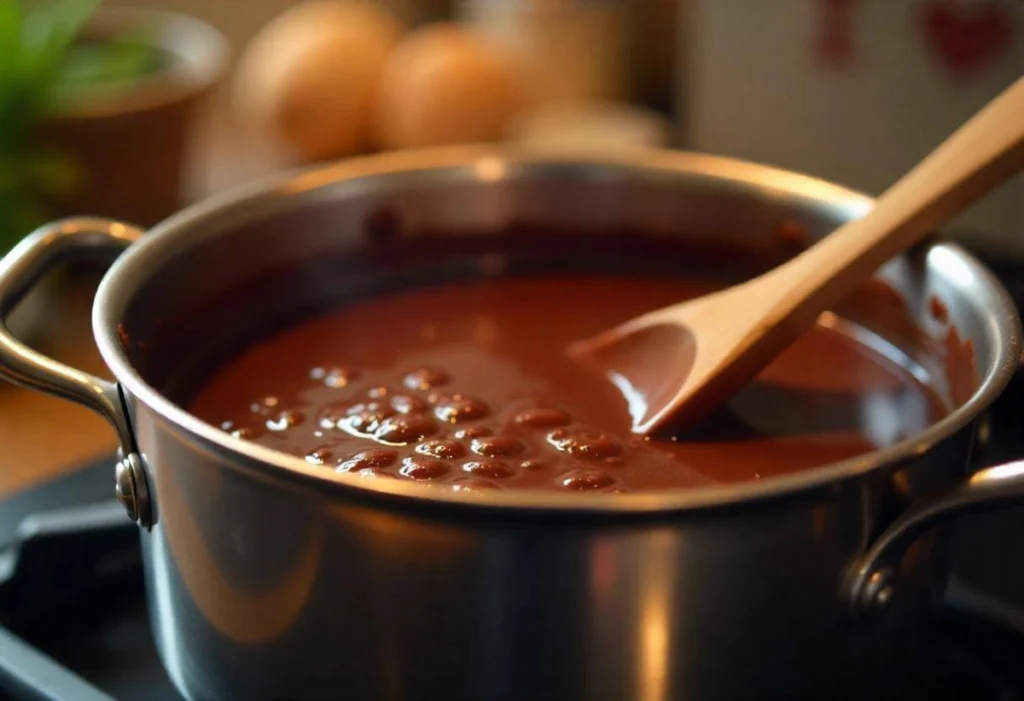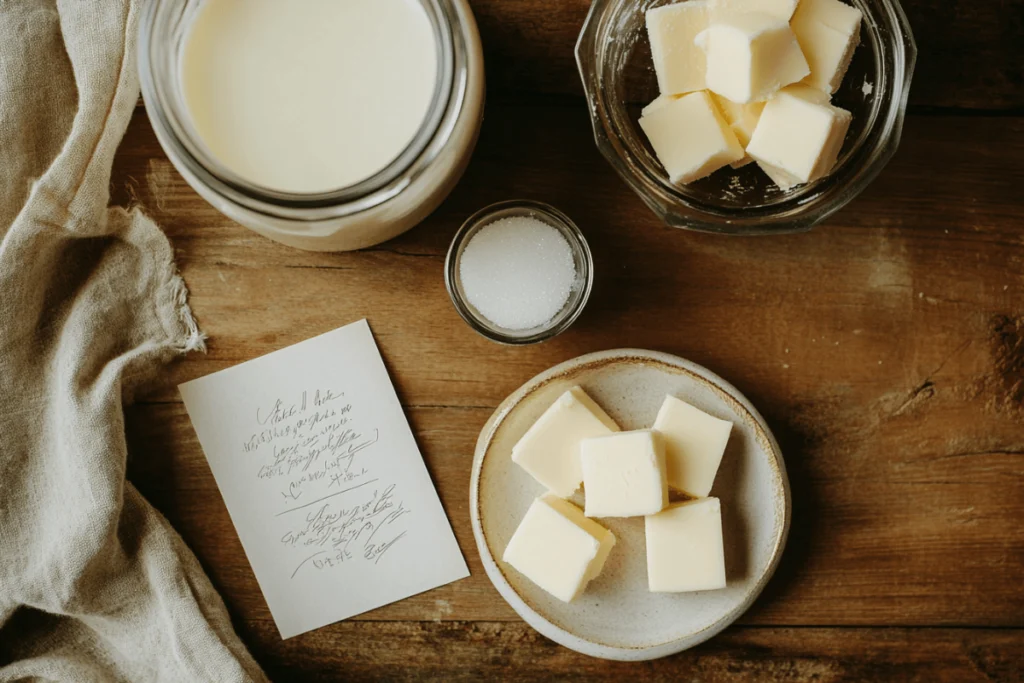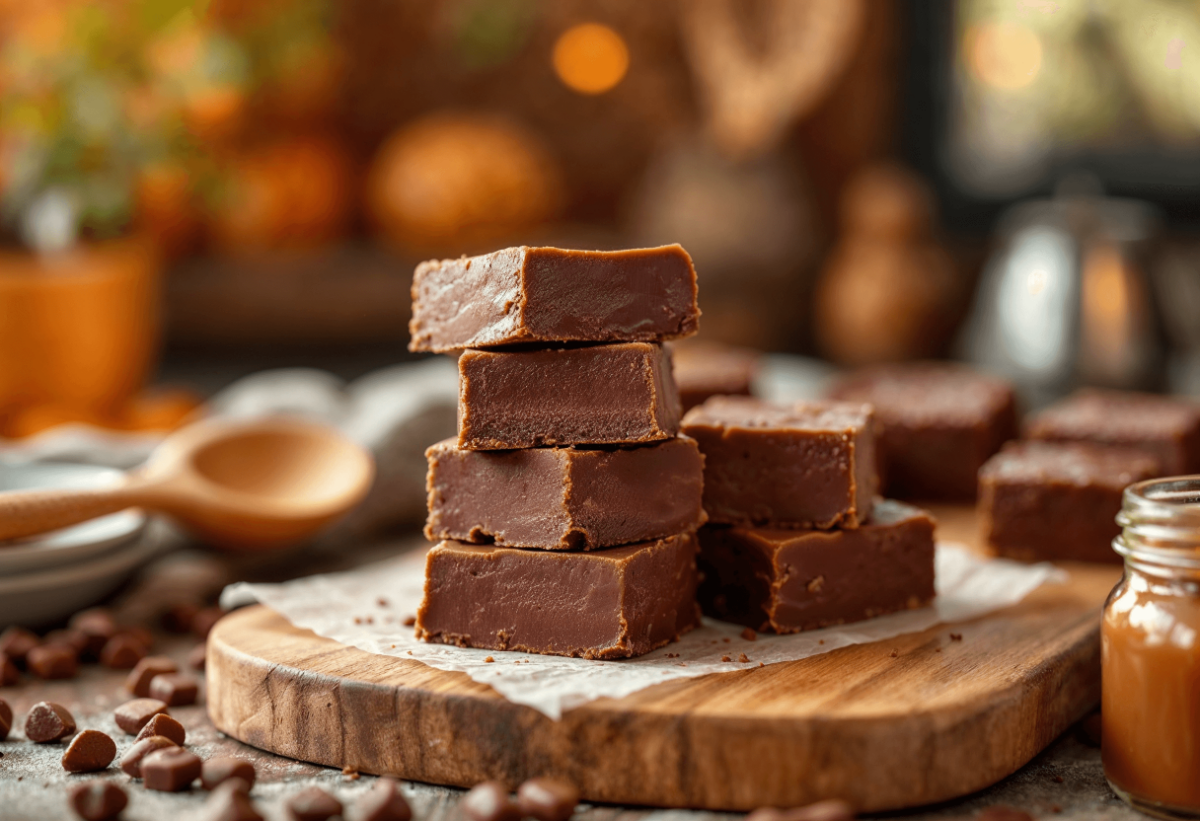Fudge—a timeless treat loved for its smooth, creamy texture—can quickly turn into a grainy, rock-hard disaster if something goes wrong. If you’ve ever wondered, “What ingredient makes fudge hard?” you’re not alone. Achieving the perfect fudge consistency isn’t just about mixing sugar, butter, and milk; it’s a delicate dance of temperature, timing, and precise ingredient ratios.
In this article, we’ll dive deep into the science behind fudge texture, exploring the role of sugar crystallization, temperature control, and the interactions between key ingredients. You’ll also learn how common mistakes can ruin your fudge and how to fix them. Whether you’re a seasoned confectioner or a first-time fudge maker, this guide will equip you with everything you need to master this sweet treat.
Table of contents
The Science Behind Fudge Texture
Creating perfect fudge isn’t just about following a recipe—it’s about understanding how each ingredient and step influences the final product. From sugar crystallization to precise temperature control, every detail matters. Let’s break down the key scientific principles behind fudge texture.

How Ingredients Interact in Fudge Recipes
Fudge is essentially an emulsion of sugar, butter, and milk, with chocolate often thrown into the mix. But the magic happens when these ingredients interact at just the right temperature. Sugar provides the structure, butter contributes richness and creaminess, and milk helps balance moisture.
- Sugar: It’s not just about sweetness. The type of sugar (granulated, brown, or corn syrup) and how it’s heated affect whether the fudge will turn out smooth or gritty.
- Butter: Beyond adding flavor, butter emulsifies the sugar and milk mixture, creating a smooth texture. However, overheating butter can cause separation, leading to oily fudge.
- Milk/Cream: Milk acts as a moisture regulator, helping prevent the sugar from crystallizing prematurely.
When these ingredients are perfectly combined, the result is fudge that’s firm yet tender. Get it wrong, and you might end up with a rock-hard brick or a sticky mess.
The Role of Sugar Crystallization in Fudge Firmness
Sugar crystallization is the make-or-break factor in fudge texture. When sugar dissolves in water and is then heated, it creates a syrup. However, as the syrup cools, sugar wants to return to its crystal form.
- Over-crystallization: If the sugar crystals form too quickly, the fudge turns grainy and unpleasant.
- Under-crystallization: If sugar doesn’t crystallize enough, the fudge won’t set and will remain overly soft.
So, what’s the sweet spot? The key is controlling the rate of crystallization. Stirring too soon or too vigorously can cause large sugar crystals to form, ruining the smooth texture. To avoid this, let the fudge mixture cool slightly before stirring.
Pro Tip: Add a small amount of corn syrup to your mixture. It interferes with sugar molecules and helps prevent unwanted crystallization.
The Importance of Temperature Control in Fudge Making
When it comes to fudge, temperature is king. Cooking fudge to the right temperature (usually between 234°F and 239°F) ensures the sugar syrup reaches the soft-ball stage. At this stage, the syrup holds its shape but remains soft and pliable.
- Too Low Temperature: Fudge won’t set properly and will remain gooey.
- Too High Temperature: Water evaporates too quickly, leaving behind a hard, dry texture.
Using a candy thermometer is non-negotiable. It takes the guesswork out of fudge-making and ensures your syrup reaches the perfect temperature.
Equally important is the cooling phase. After reaching the desired temperature, allow the mixture to cool to about 110°F to 113°F before stirring. Stirring too soon can lead to graininess, while stirring too late may result in uneven crystallization.
Key Ingredients That Affect Fudge Hardness
When it comes to achieving the perfect fudge texture, ingredients are everything. Each plays a specific role in determining whether your fudge ends up soft, hard, grainy, or smooth. So, what ingredient makes fudge hard? It’s not just one—it’s the interaction between sugar, butter, milk, and sometimes corn syrup. Let’s break it down

How Sugar Affects Fudge Firmness and Texture
Sugar isn’t just for sweetness; it’s the backbone of fudge texture. The way sugar crystals behave during cooking and cooling determines if your fudge will be smooth and creamy or hard and brittle.
- Sugar Crystallization: When sugar crystals are allowed to form too quickly, they create a gritty texture. Stirring too early can also trigger this problem.
- Sugar Concentration: The higher the sugar concentration, the harder your fudge will be. Cooking the mixture to the soft-ball stage (234°F–239°F) ensures the right balance.
- Type of Sugar: Granulated sugar is most common, but alternatives like brown sugar or corn syrup can influence the outcome.
So, what ingredient makes fudge hard? Sugar, when overcooked or improperly handled, can lead to a tough texture. Always measure accurately and monitor temperatures closely.
The Role of Butter and Milk in Fudge Consistency
Butter and milk aren’t just flavor enhancers—they act as emulsifiers that keep fudge smooth and creamy.
- Butter: It adds richness and prevents sugar crystals from forming large, gritty structures. But overheating butter can cause it to separate, creating an oily texture.
- Milk: Milk provides moisture and balances the sugar concentration. The fat content in milk also acts as a barrier against unwanted sugar crystallization.
- Evaporated Milk: Many recipes call for evaporated milk because it has a higher sugar concentration, helping achieve a more stable texture.
Balancing butter and milk in the right proportions is crucial. Too little, and your fudge becomes crumbly; too much, and it may not set at all.
How Corn Syrup Prevents Sugar Crystals from Forming
Corn syrup often acts as the unsung hero in fudge recipes. Even a small amount can make a big difference in texture.
- Crystal Inhibitor: Corn syrup contains glucose, which interrupts sugar molecules from bonding together and forming large crystals.
- Smooth Texture: Adding just a tablespoon of corn syrup helps keep your fudge silky smooth and prevents grittiness.
- Alternative Ingredients: If corn syrup isn’t available, honey or maple syrup can serve as substitutes, although they may slightly alter the flavor.
In recipes that require absolute precision, corn syrup is a reliable ingredient for preventing hard, grainy fudge.
Common Mistakes That Make Fudge Too Hard or Too Soft
Even with the best ingredients and equipment, small errors in the cooking process can lead to disappointing results. So, what ingredient makes fudge hard might not always be the question—it’s often about how you handle those ingredients. Let’s dive into the most common mistakes and how to avoid them.
Cooking Time and Temperature Errors
Temperature is everything in fudge-making. If you don’t cook your mixture to the right temperature, you’re almost guaranteed to end up with an undesirable texture.
- Under-Cooking: If the sugar mixture doesn’t reach the soft-ball stage (234°F–239°F), your fudge won’t set properly and will remain sticky or gooey.
- Over-Cooking: On the other hand, cooking it past 239°F removes too much moisture, resulting in rock-hard fudge.
- Solution: Always use a candy thermometer. Avoid relying on visual cues alone, as they can be misleading.
For a simple yet effective recipe that nails the balance of temperature and texture, check out 3-Ingredient Peanut Butter Fudge. It’s an excellent example of how a few well-measured ingredients can create the perfect consistency.
Overbeating or Underbeating Fudge Mixture
Once your fudge mixture reaches the correct temperature and begins to cool, beating is the next critical step.
- Overbeating: Beating fudge excessively can cause it to harden too quickly, resulting in a crumbly texture.
- Underbeating: If you don’t beat it enough, the sugar won’t crystallize properly, leaving you with a gooey mess.
- Solution: Start beating when the mixture has cooled to about 110°F–113°F and stop as soon as it begins to lose its gloss.
Stirring at the wrong time can undo all your careful cooking efforts, so patience is key.
Using Incorrect Ingredient Ratios
Fudge is a delicate balance of sugar, butter, and milk. Even small deviations in measurements can disrupt the final texture.
- Too Much Sugar: Excess sugar can make your fudge overly hard and brittle.
- Too Little Fat: A lack of butter or milk can result in dry, crumbly fudge.
- Solution: Always follow the recipe measurements precisely and avoid eyeballing ingredients.
If you’re still wondering, “What ingredient makes fudge hard?” the answer often lies in how the sugar is managed during cooking and cooling.
Fixing Hard or Soft Fudge – Troubleshooting Guide
Fudge can be a delightful treat, but even experienced bakers encounter challenges. Whether your fudge turned out rock-hard, too soft, or somewhere in between, there’s usually a solution. Let’s break down common problems and how to fix them.
How to Soften Overcooked Fudge
Overcooked fudge is one of the most common mistakes in candy-making. If your batch feels more like brittle candy than smooth fudge, don’t worry—it’s still salvageable.
- Reheat and Add Liquid: Place the hardened fudge back in a heavy-bottomed pot. Add about 1/4 cup of cream or milk and gently reheat over low heat. Stir constantly until the mixture becomes smooth again.
- Re-Boil to the Right Temperature: Use a candy thermometer to ensure the mixture reaches the soft-ball stage (around 234°F–239°F).
- Pour and Cool Again: Once reheated properly, pour the mixture into a prepared pan and allow it to set again.
Understanding what ingredient makes fudge hard often ties back to sugar crystallization and cooking temperature. Paying close attention to these factors can prevent this mistake in future batches.
Fixing Fudge That Didn’t Set Properly
When fudge doesn’t set and remains gooey, it’s usually because it wasn’t cooked to a high enough temperature.
- Reheat the Fudge: Return the mixture to a saucepan and reheat slowly until it reaches the soft-ball stage.
- Add a Stabilizer: A tablespoon of corn syrup can help prevent unwanted sugar crystallization during reheating.
- Cool Properly Before Stirring: Let the mixture cool undisturbed to about 110°F–113°F before beating.
By controlling the temperature and stirring process, you’ll significantly increase your chances of achieving perfect fudge consistency.
Preventing Common Fudge Mistakes in Future Batches
Consistency is key when it comes to fudge-making. Here are some practical tips:
- Use a Candy Thermometer: Always rely on an accurate candy thermometer instead of guesswork.
- Avoid Stirring Too Soon: Stirring too early can cause graininess.
- Follow Measurements Closely: Precise ingredient ratios are crucial for texture.
Expert Tips for Perfect Fudge Every Time
Perfect fudge doesn’t happen by accident. With the right tools, techniques, and a little patience, you can master this classic treat. Here are expert tips to guide you.
Choosing the Right Equipment for Fudge Making
The right equipment can make or break your fudge-making experience.
- Heavy-Bottomed Pot: A heavy-bottomed stainless steel pot ensures even heating and prevents scorching.
- Candy Thermometer: Precision is everything. A reliable thermometer helps you hit the soft-ball stage.
- Wooden Spoon: Use a wooden spoon or silicone spatula for stirring—it doesn’t conduct heat and won’t scratch your pot.
When considering what ingredient makes fudge hard, remember that equipment plays a key supporting role in achieving the right consistency.
Best Practices for Measuring Ingredients Accurately
Accurate measurements are the backbone of perfect fudge.
- Use a Digital Kitchen Scale: Measuring by weight is more accurate than using measuring cups.
- Level Your Ingredients: When measuring dry ingredients like sugar, level them off with a flat edge.
- Follow Recipe Ratios Precisely: Even slight deviations can lead to texture issues.
Precision ensures your sugar syrup cooks correctly, preventing both overly hard and soft fudge.
How to Store Fudge for Optimal Texture
Proper storage keeps your fudge fresh and delicious.
- Room Temperature: Store fudge in an airtight container at room temperature for up to two weeks.
- Refrigeration (Optional): If you prefer longer storage, refrigerate your fudge. Bring it to room temperature before serving.
- Avoid Humidity: Excess moisture can ruin the texture, causing it to become sticky.
When stored correctly, fudge maintains its signature smooth texture and rich flavor.
For more insights on achieving a consistently smooth texture, don’t miss The Secret to Soft Fudge. This guide dives deeper into preventing texture issues and troubleshooting common fudge-making problems.
FAQs Section
Fudge becomes hard primarily due to sugar crystallization. When sugar is heated to the soft-ball stage (234°F–239°F) and then allowed to cool and crystallize properly, it creates a firm structure. However, overcooking the mixture, letting it exceed this temperature, or not incorporating enough moisture from ingredients like butter or milk can also result in excessively hard fudge.
The firm texture of fudge comes from a balanced combination of sugar, butter, and milk heated to the correct temperature. The sugar concentration determines the final texture, while butter and milk contribute moisture and fat, preventing sugar crystals from forming too large. Proper cooling and stirring are equally essential to ensure a smooth and firm consistency.
The secret to perfect fudge lies in precise temperature control and patience during cooling and stirring. Always cook the sugar mixture to the soft-ball stage (234°F–239°F) using a candy thermometer. Allow the mixture to cool undisturbed to around 110°F before stirring. Additionally, using stabilizing ingredients like corn syrup can help prevent unwanted sugar crystallization.
If your fudge isn’t hardening, it’s usually because it wasn’t cooked to a high enough temperature (below 234°F) or there’s too much moisture in the mixture. It could also result from insufficient cooling time before stirring. To fix it, gently reheat the mixture and cook it to the proper soft-ball stage temperature, then let it cool undisturbed before stirring. Adding a stabilizer, like corn syrup, can also help.
Final Thoughts
Fudge-making is a balance of precision, patience, and the right ingredients. If you’ve ever asked, “What ingredient makes fudge hard?” the answer lies in how sugar crystallizes and how temperature is managed during cooking and cooling.
Key takeaways for perfect fudge:
- Cook to the soft-ball stage (234°F–239°F).
- Cool undisturbed before stirring.
- Follow ingredient ratios precisely.
Every batch is a chance to refine your skills. With the right tools and attention to detail, you’ll soon be crafting smooth, creamy fudge every time.
Happy cooking and sweet results! 🍫✨



